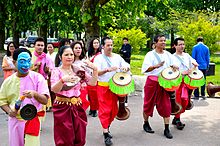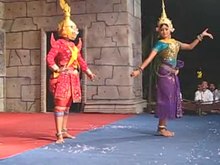Khmer (people)
The Khmer ( ខ្មែរ ˈ: k: m: ɛər ) (also Camarini, Coa Mein, Kambuja, Kampuch, Khmae, Khom, Kui kmi, Kumar or Mein ) are the largest ethnic group in Cambodia and have more than 15.5 million inhabitants over 97 percent of the population. In total there are over 18 million Khmer worldwide (as of 2014). In past centuries they were resettled as workers in neighboring countries ( Thailand , Laos and Vietnam ), sometimes with violence. Around three million Khmer now live in neighboring countries. A relatively large group of the Khmer, who had to flee from the Khmer Rouge and the subsequent occupation of the communist Viet Cong, now live in the country of the former colonial rulers of Cambodia, in France , but also in the USA .
The Khmer built temples and temple cities that are among the largest in the world, such as Angkor in present-day Cambodia and Prasaat Hin Khao-Phnom-Rung and Prasaat Hin Phimai in present-day Thailand .
The Khmer are closely related to the mountain people of the Mon , whose descendants in Thailand mainly live as rice farmers and fishermen. Numerous minorities in southern Laos, northeast Cambodia and central Vietnam also speak related languages.
The Khmer have experienced numerous ups and downs throughout Cambodia's history . Their past is very closely linked to the history of the Cham , with whom they were regularly at war from the 10th to the 15th century. Contemporary history includes the terror regime and the crimes of the Khmer Rouge , which killed more than three million Khmer people between 1975 and 1979.
History of the Khmer
Probably in the 3rd century BC Proto-Mon-Khmer migrated south from China, but the first Khmer empire did not emerge until 802 under the ruler Jayavarman II , after he had defeated Chenla . After his death in 850, his son Jayavarman III took over . in the capital Hariharalaya the throne. The Khmer established the first cult center of the Khmer monarchy in Angkor , Yasodharapura , in 893 and successfully attacked the Vietnamese Empire of Champa more than fifty years later . In the 12th century King took Jayavarman VII. The Theravada Buddhism and began the construction of Angkor Thom . End of the 12th century, all the Khmer were practically from Hinduism to Buddhism converts .
The history of the empire of the same name ended with the conquest of Angkor by the Thai (Siam) from Ayutthaya in the 14th century. The capital was abandoned the following year. As a result, the Khmer were for most of the time a bone of contention between the Vietnamese Empire of Annam and the Siamese Empire of Ayutthaya. After a Vietnamese princess married into the Khmer monarchy in 1620, the Vietnamese received the right to settle in Khmer territory. This led to the Vietnamization of the eastern coastal region of the former Cambodia, today located around Saigon (Ho Chi Minh City).
King Norodom I led the Khmer into French colonial rule in 1863 when he asked for France to be protected from attacks by its neighbors. The Khmer territory was initially a French protectorate , but in 1887 it was incorporated into the French Indochina colony . Cambodia only gained independence in 1953.
language
The Khmer speak the Khmer language , which is part of the Mon Khmer language family. The Khmer script is derived from the Indian syllabary scripts.
religion
In the ethnic religion mountains, hills, springs, trees and fields are populated by spirits (→ animism ) , who control the fate of the earth and are now called Neak-Ta . Vishnu himself was the “great spirit king” Neak-Ta-Moha-Reach . These spirits need to be always gracious. The arak , sickness spirits, and the spirits of the untimely deceased, the Khomorchhav , are dangerous . Belief in demons is widespread.
Web links
- Khmer Institute , non-profit organization
- Art and history of the Khmer in cosmopolis.ch
Individual evidence
- ^ The World Factbook - Central Intelligence Agency. Retrieved September 13, 2018 .
- ^ Marilia Albanese: Angkor. Forgotten temples. Weltbild Verlag, Augsburg 2002, ISBN 3-8289-0823-3 , p. 72.


